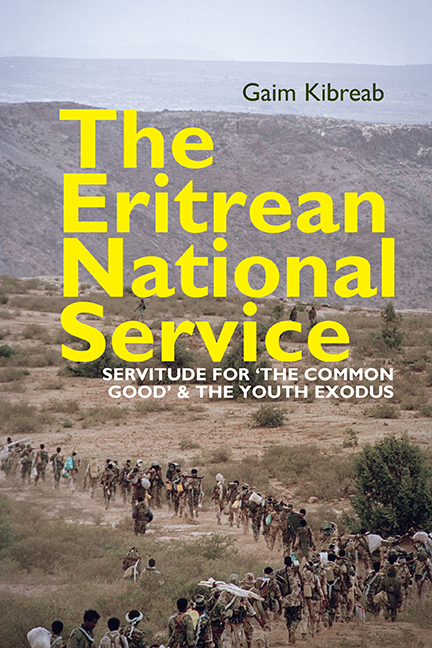Book contents
- Frontmatter
- Dedication
- Contents
- List of Figures and Tables
- Foreword
- Acknowledgements
- List of Acronyms & Abbreviations
- 1 Introduction
- 2 National/Military Service in Africa: Theories and Concepts
- 3 The Government and the Structure of the Eritrean Defence Force
- 4 The Nature of the Eritrean National Service and its Effectiveness as a Fighting Force
- 5 The Eritrean National Service as a Mechanism of Preserving and Transmitting the Core Values of the Liberation Struggle
- 6 The Eritrean National Service: A Vehicle for National Unity and Cohesion
- 7 The Eritrean National Service and Forced Equality
- 8 The Overarching Impact of the Eritrean National Service on the Social Fabric of Eritrean Society
- 9 Impact of the Open-Ended Eritrean National Service on Families and Conscripts
- 10 Conclusion
- Postscript: The UK Upper Tribunal (Immigration and Asylum Chamber) Country Guidance on Eritrea
- References
- Index
- Miscellaneous Endmatter
3 - The Government and the Structure of the Eritrean Defence Force
Published online by Cambridge University Press: 11 August 2017
- Frontmatter
- Dedication
- Contents
- List of Figures and Tables
- Foreword
- Acknowledgements
- List of Acronyms & Abbreviations
- 1 Introduction
- 2 National/Military Service in Africa: Theories and Concepts
- 3 The Government and the Structure of the Eritrean Defence Force
- 4 The Nature of the Eritrean National Service and its Effectiveness as a Fighting Force
- 5 The Eritrean National Service as a Mechanism of Preserving and Transmitting the Core Values of the Liberation Struggle
- 6 The Eritrean National Service: A Vehicle for National Unity and Cohesion
- 7 The Eritrean National Service and Forced Equality
- 8 The Overarching Impact of the Eritrean National Service on the Social Fabric of Eritrean Society
- 9 Impact of the Open-Ended Eritrean National Service on Families and Conscripts
- 10 Conclusion
- Postscript: The UK Upper Tribunal (Immigration and Asylum Chamber) Country Guidance on Eritrea
- References
- Index
- Miscellaneous Endmatter
Summary
The only defence against the world is a thorough knowledge of it.
John Locke, ‘Some thoughts concerning education’, 1693As seen in Chapter 1, according to the proclamation on the Eritrean National Service (ENS), all ablebodied Eritrean nationals aged between eighteen and forty are required to perform eighteen months of national service. Following the 1998–2000 border war against Ethiopia and the introduction of the WYDC, the ENS has become openended. Since then, with few exceptions, no demobilisation has taken place. At the end of 2012, the President intensified the process of militarisation by establishing the socalled Hizbawi Serawit (people's militia) comprising citizens up to the age of seventy for men and sixty for women, who were directly accountable to him. The level of militarisation in the country is unparalleled in modern history (see Hirt and Mohammad 2013; Pool 2013; Tronvoll and Mekonen 2014). The reality in Eritrea is almost identical to the archaic feudal institution of posse comitatus which, as seen in Chapter 2, refers to the intrinsic ‘power of the country’ to call upon a posse, that is, ablebodied men and women, to provide military service and to serve in national defence, law enforcement, maintenance of peace and so on against their will and without remuneration. Herein lies the link between the ENS and the old tradition of posse comitatus, or bondage. The accounts of the respondents interviewed in this study clearly show that Eritrean citizens are required by law to relinquish their rights over their labour power, and indeed their lives.
This chapter discusses the background of the Eritreanmilitary, especially the state of the military and its relationship with the government before and after the implementation of the ENS. The organisational structure of the Eritrean military and the constant changes it has been undergoing over time are also discussed. The rationales underlying President Isaias Afwerki's decision to constantly reshuffle the higher echelon of the army and to alter its organisational structure erratically are analysed. Notwithstanding the fact that in May 2016 the government had just celebrated its twenty-fifth anniversary, ironically, the organisational structure of the Eritrean military still remains in a state of flux.
- Type
- Chapter
- Information
- The Eritrean National ServiceServitude for 'the common good' and the Youth Exodus, pp. 36 - 51Publisher: Boydell & BrewerPrint publication year: 2017

